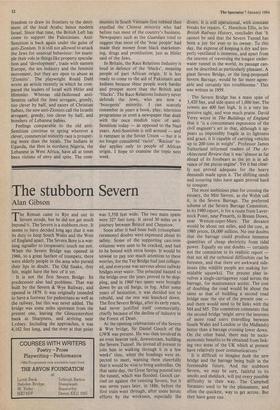The stubborn Severn
Alan Gibson
The Roman came to Rye and out to Severn strode, but he did not get much beyond it. The Severn is a stubborn river. It seems to have decided long ago that it was its duty to keep South Wales and the West of England apart. The Severn Bore is a war- ning signaller to trespassers: touch me not. When the Severn Bridge was opened in 1966, to a great fanfare of trumpets, there were elderly people in the area who pursed their lips in doubt. The Old Snake, they felt, might have the best of it yet.
It is not the first Severn Bridge. Its predecessor also had problems. That was built by the Severn & Wye Railway, and opened in 1879. It was originally intended to have a footway for pedestrians as well as the railway, but this was never added. The bridge was some miles upstream from the present one, leaving the Gloucestershire bank at Sharpness, and arriving near Lydney. Including the approaches, it was 4,162 feet long, and the river at that point was 3,558 feet wide. The two main spans were 327 feet long. It saved 30 miles on a journey between Bristol and Chepstow.
Soon after it had been built (triumphant ceremony) doubts were expressed about its safety. Some of the supporting cast-iron columns were seen to be cracked, and had to be bound with extra hoops. It would be unwise to pay too much attention to these worries, for the Tay Bridge had just collaps- ed, and everyone was nervous about railway bridges over water. The principal hazard to the bridge over the years proved to be ship- ping, and in 1960 two spans were brought down by an oil barge, in fog. After some years of hesitation, it was decided not to rebuild, and the rest was knocked down. The first Severn Bridge, after its early years, had never justified itself commercially, chiefly because of the decline of industry in the Forest of Dean.
At the opening celebrations of the Severn & Wye bridge, Sir Daniel Gooch of the GWR was present. He was then involved in an even heavier task, downstream, building the Severn Tunnel. He invited all present to join him in walking through it in a few weeks' time, when the headings were ex- pected to meet, warning them cheerfully that it would be wise to bring umbrellas. On that same day, the Great Spring poured into the tunnel, which was flooded. Gooch car- ried on against the resisting Severn, but it was seven years later, in 1886, before the first train went through, after some heroic efforts by the workmen, especially the
divers. It is still operational, with constant breaks for repairs. C. Hamilton Ellis, in his British Railway History, concludes that 'It cannot be said that the Severn Tunnel has been a joy for ever to its owner. To this day, the expense of keeping it dry and pro- perly ventilated is immense, and apart from the interest of traversing the longest under- water tunnel in the world, its passage can- not be described as particularly pleasant. A giant Severn Bridge, or the long-proposed Severn Barrage, would be far more agree- able and certainly less troublesome.' This was written in 1959.
The Severn Bridge has a main span of 3,420 feet, and side spans of 1,000 feet. The towers are 400 feet high. It is a very im- pressive sight, and won much praise. David Verey wrote in The Buildings of England that it 'is a consummate expression of the civil engineer's art in that, although it ap- pears so impossibly fragile in its lightness and grace, it is capable of carrying vehicles up to 200 tons in weight'. Professor James Sutherland informed readers of The Ar- chitectural Review that it was 'almost as far ahead of its forebears as the jet is in ad- vance of the piston engine'. Yet it has clear- ly not proved adequate for the heavy demands made upon it. The shifting sands and scouring tides have again proved hard to conquer.
The most ambitious plan for crossing the estuary, the Mor Savren, as the Welsh call it, is the Severn Barrage. The preferred scheme of the Severn Barrage Committee, in its 1980 report, is for a route from Laver- nock Point, near Penarth, to Bream Down, near Weston-super-Mare. The distance would be about ten miles, and the cost, at 1980 prices, £6,000 million. No one doubts that the barrage could produce immense quantities of cheap electricity from tidal power. Equally no one doubts — certainly not the committee in its realistic report that not all the technical difficulties can be foreseen, and that there are awkward side- issues (the wildlife people are making for- midable squawks). The present plan in- volves a single-carriageway road across the barrage, for maintenance access. The cost of doubling the road would be about the same as that of building a second road bridge near the site of the present one and there would need to be links with the M4 and M5. The committee comments that the second bridge 'might serve the interests of more road users (travelling between South Wales and London or the Midlands) better than a barrage crossing lower down. On the other hand, there may be socio- economic benefits to be obtained from link- ing two areas of the UK which at present have relatively poor communications.'
It is difficult to imagine both the new bridge and the barrage being built in the foreseeable future. And the stubborn Severn, we may be sure, faithful to its smolts and shelduck, will put every possible difficulty in their way. The Campbell Steamers used to be the pleasantest, and often the quickest, way to get across. But they have gone too.


































 Previous page
Previous page